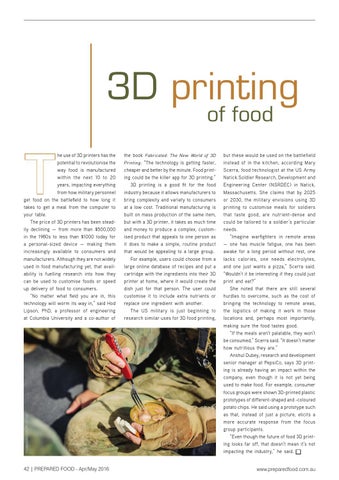3D printing of food
he use of 3D printers has the
the book Fabricated: The New World of 3D
but these would be used on the battlefield
potential to revolutionise the
Printing. “The technology is getting faster,
instead of in the kitchen, according Mary
way food is manufactured
cheaper and better by the minute. Food print-
Scerra, food technologist at the US Army
within the next 10 to 20
ing could be the killer app for 3D printing.”
Natick Soldier Research, Development and
years, impacting everything
3D printing is a good fit for the food
Engineering Center (NSRDEC) in Natick,
from how military personnel
industry because it allows manufacturers to
Massachusetts. She claims that by 2025
get food on the battlefield to how long it
bring complexity and variety to consumers
or 2030, the military envisions using 3D
takes to get a meal from the computer to
at a low cost. Traditional manufacturing is
printing to customise meals for soldiers
your table.
built on mass production of the same item,
that taste good, are nutrient-dense and
The price of 3D printers has been stead-
but with a 3D printer, it takes as much time
could be tailored to a soldier’s particular
ily declining — from more than $500,000
and money to produce a complex, custom-
needs.
in the 1980s to less than $1000 today for
ised product that appeals to one person as
“Imagine warfighters in remote areas
a personal-sized device — making them
it does to make a simple, routine product
— one has muscle fatigue, one has been
increasingly available to consumers and
that would be appealing to a large group.
awake for a long period without rest, one
manufacturers. Although they are not widely
For example, users could choose from a
lacks calories, one needs electrolytes,
used in food manufacturing yet, that avail-
large online database of recipes and put a
and one just wants a pizza,” Scerra said.
ability is fuelling research into how they
cartridge with the ingredients into their 3D
“Wouldn’t it be interesting if they could just
can be used to customise foods or speed
printer at home, where it would create the
print and eat?”
up delivery of food to consumers.
dish just for that person. The user could
She noted that there are still several
customise it to include extra nutrients or
hurdles to overcome, such as the cost of
replace one ingredient with another.
bringing the technology to remote areas,
“No matter what field you are in, this technology will worm its way in,” said Hod Lipson, PhD, a professor of engineering
The US military is just beginning to
the logistics of making it work in those
at Columbia University and a co-author of
research similar uses for 3D food printing,
locations and, perhaps most importantly, making sure the food tastes good. “If the meals aren't palatable, they won’t be consumed,” Scerra said. “It doesn’t matter how nutritious they are.” Anshul Dubey, research and development senior manager at PepsiCo, says 3D printing is already having an impact within the company, even though it is not yet being used to make food. For example, consumer focus groups were shown 3D-printed plastic prototypes of different-shaped and -coloured
© kaninstudio/Dollar Photo Club
potato chips. He said using a prototype such
42 | PREPARED FOOD - Apr/May 2016
as that, instead of just a picture, elicits a more accurate response from the focus group participants. “Even though the future of food 3D printing looks far off, that doesn’t mean it’s not impacting the industry,” he said.
www.preparedfood.com.au
